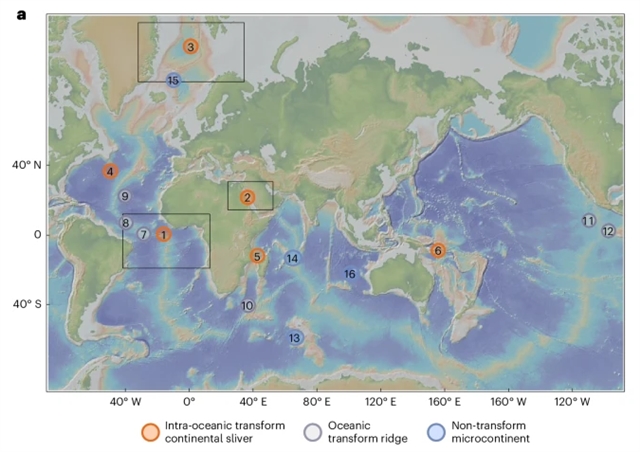
近日,瑞士苏黎世联邦理工学院Attila Balázs团队揭示了裂谷继承决定了大洋转换断层中大陆条的存在。这一研究成果于2025年9月25日发表《自然—地球科学》杂志上。
板块构造理论描述了大陆如何通过横向运动分开的,这种横向运动是由连接海洋中脊部分的转换断层所容纳的,这在海底留下了不活跃的断裂带。在这些距离大陆数百公里至1000公里的断裂带中,大陆碎屑条的出现已经在世界范围内得到了记录,但从经典板块构造理论来看,它们的出现是不可能的。
研究组通过三维岩浆热力学数值模拟研究大陆裂谷到大洋转换断裂带形成的转变及其与地幔熔融和地壳构造的关系。这些模拟结果表明,大陆条状物被包裹在前大陆裂陷阶段遗留下来的海洋剪切带内。它们还表现出三个不同阶段的转换断裂带的形成-大陆裂谷联系,原始转换,海洋转换-由渐进应变局部化为狭窄的伸展-平行走滑剪切带。此外,研究表明,大陆碎块嵌入大洋岩石圈的过程与特定的沉降和抬升阶段相关,这些阶段受转换拉伸和转换挤压应力场变化的控制。这一过程会显著改变海底形态、洋中脊熔融条件以及转换断层的震活动性。
附:英文原文
Title: Presence of continental slivers in oceanic transform faults determined by rift inheritance
Author: Balzs, Attila, Gerya, Taras, Tari, Gbor
Issue&Volume: 2025-09-25
Abstract: The theory of plate tectonics describes how continents are separated from each other by lateral movement that is accommodated by transform faults connecting mid-ocean ridge sections, which leaves inactive fracture zones on the ocean floor. The occurrence of continental crustal slivers in these fracture zones at distances of hundreds of kilometres to 1,000 kilometres from continents has been documented worldwide, yet their occurrence is not expected from classical plate tectonic theory. Here we use three-dimensional magmatic-thermomechanical numerical simulations to investigate the transition from continental rifting to the birth of oceanic transform fault zones and their relationship to mantle melting and crustal tectonics. These simulations show that continental slivers are entrapped within shear zones in the oceans inherited from preceding continental rifting stage. They also show three distinct stages of transform fault zone formation—continental rift linkage, proto-transform, oceanic transform—resulting from progressive strain localization into a narrowing extension-parallel strike-slip shear zone. Additionally, continental sliver emplacement into oceanic lithosphere is shown to be associated with specific stages of subsidence and uplift linked to the changing transtensional and transpressional stress field, thereby notably modifying the ocean floor morphology, mid-ocean ridge melting conditions and transform fault seismicity.
DOI: 10.1038/s41561-025-01795-0
Source: https://www.nature.com/articles/s41561-025-01795-0
